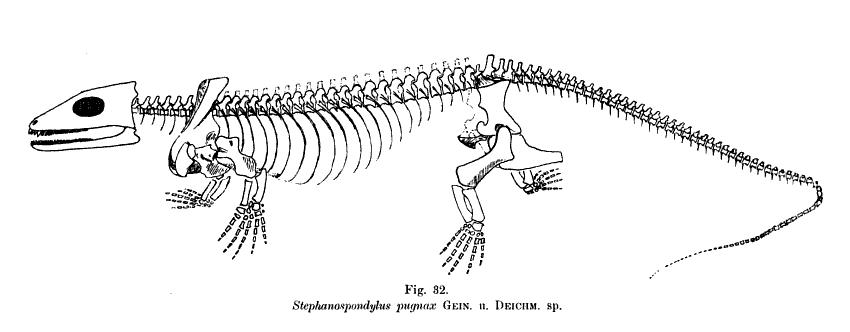Stephanospondylus on:
[Wikipedia]
[Google]
[Amazon]
''Stephanospondylus'' is an extinct
 ''Stephanospondylus'' is known only from several vertebrae and fragments of the upper and lower jaws. It was named in 1882 on the basis of two slabs, the fossils in which were thought to represent two individuals. With the erection of a new genus in 1905, the fossils were considered to be part of a single individual. In 1925, Alfred Romer determined that only parts of the jaws and some vertebrae belonged to ''Stephanospondylus''; the other material belonged to the
''Stephanospondylus'' is known only from several vertebrae and fragments of the upper and lower jaws. It was named in 1882 on the basis of two slabs, the fossils in which were thought to represent two individuals. With the erection of a new genus in 1905, the fossils were considered to be part of a single individual. In 1925, Alfred Romer determined that only parts of the jaws and some vertebrae belonged to ''Stephanospondylus''; the other material belonged to the
genus
Genus ( plural genera ) is a taxonomic rank used in the biological classification of living and fossil organisms as well as viruses. In the hierarchy of biological classification, genus comes above species and below family. In binomial n ...
of diadectid reptiliomorph from the Early Permian 01 or '01 may refer to:
* The year 2001, or any year ending with 01
* The month of January
* 1 (number)
Music
* 01'' (Richard Müller album), 2001
* ''01'' (Son of Dave album), 2000
* ''01'' (Urban Zakapa album), 2011
* ''O1'' (Hiroyuki Sawano ...
of Germany
Germany, officially the Federal Republic of Germany (FRG),, is a country in Central Europe. It is the most populous member state of the European Union. Germany lies between the Baltic and North Sea to the north and the Alps to the sou ...
. Fossils have been found in deposits of the Lower Rotliegend near Dresden
Dresden (, ; Upper Saxon: ''Dräsdn''; wen, label=Upper Sorbian, Drježdźany) is the capital city of the German state of Saxony and its second most populous city, after Leipzig. It is the 12th most populous city of Germany, the fourth ...
. The type species
In zoological nomenclature, a type species (''species typica'') is the species name with which the name of a genus or subgenus is considered to be permanently taxonomically associated, i.e., the species that contains the biological type specimen( ...
''S. pugnax'' was originally referred to the genus ''Phanerosaurus
''Phanerosaurus'' is an extinct genus of diadectid reptiliomorph from the Early Permian of Germany. Fossils are known from the Leukersdorf Formation near Zwickau. German paleontologist Christian Erich Hermann von Meyer named the type species ...
'' in 1882 but was placed in its own genus in 1905.
Description
 ''Stephanospondylus'' is known only from several vertebrae and fragments of the upper and lower jaws. It was named in 1882 on the basis of two slabs, the fossils in which were thought to represent two individuals. With the erection of a new genus in 1905, the fossils were considered to be part of a single individual. In 1925, Alfred Romer determined that only parts of the jaws and some vertebrae belonged to ''Stephanospondylus''; the other material belonged to the
''Stephanospondylus'' is known only from several vertebrae and fragments of the upper and lower jaws. It was named in 1882 on the basis of two slabs, the fossils in which were thought to represent two individuals. With the erection of a new genus in 1905, the fossils were considered to be part of a single individual. In 1925, Alfred Romer determined that only parts of the jaws and some vertebrae belonged to ''Stephanospondylus''; the other material belonged to the temnospondyl
Temnospondyli (from Greek τέμνειν, ''temnein'' 'to cut' and σπόνδυλος, ''spondylos'' 'vertebra') is a diverse order of small to giant tetrapods—often considered primitive amphibians—that flourished worldwide during the Carb ...
amphibian '' Onchiodon''.
''Stephanospondylus'' has spade-shaped teeth adapted to cutting plant material. The vertebrae are distinct from those of other diadectids in that they lack hyposphene-hypantrum articular surfaces. The holotype
A holotype is a single physical example (or illustration) of an organism, known to have been used when the species (or lower-ranked taxon) was formally described. It is either the single such physical example (or illustration) or one of seve ...
specimen may represent a juvenile form of another diadectid. Because so little is known of the genus, the relationship of ''Stephanospondylus'' to other diadectids is poorly known.
References
Diadectids Cisuralian tetrapods of Europe Permian Germany Fossils of Germany Fossil taxa described in 1905 {{Permian-animal-stub